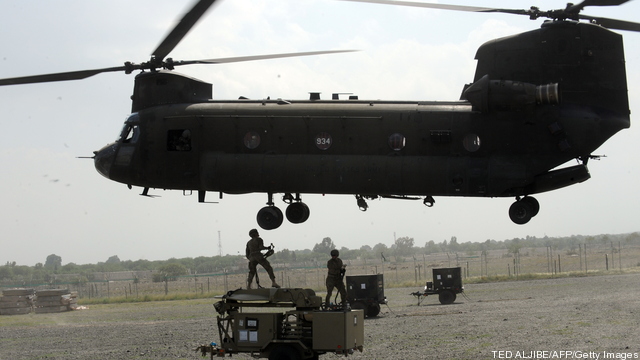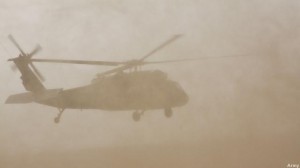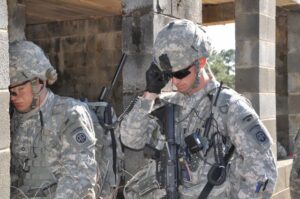The 100 Year Helicopter: Sign Of Army Helo Fleet’s Vulnerability
Posted on

Army CH-47 Chinook in Afghanistan
ARLINGTON: You probably don’t plan to keep your current car for 20 years. But that’s what the US Army has to do with its helicopter fleet. With the Armed Aerial Scout (AAS) helicopter stillborn for lack of funds and the Future Vertical Lift (FVL) family not entering production until the 2030s, the Army has to invest carefully to keep its current choppers not only flyable but viable against ever more sophisticated threats.
“We’re kind of in a period of vulnerability right now,” said Maj. Gen. Michael Lundy, head of the Army’s aviation branch, to the Association of the US Army yesterday. “We’re betting on Future Vertical Lift — increased speed, range, survivability, the ability to operate in all environments… but we can’t allow the current force that we’ve got, the current legacy aircraft that we’ve got, to lag behind.”
The first FVL variant will start production in 2030, but the Army won’t have a full brigade’s worth until 2037 — at which point it will still field thousands of Apaches, Black Hawks and Chinooks. In fact, said Lundy, the last CH-47 Chinook won’t retire until 2065, a century after the aircraft first entered service in Vietnam: “It’s going to be a 100-year aircraft because we don’t have a replacement.”
That’s the bad news. Here’s the good news: The service doesn’t have to wait for FVL to make its current choppers much more capable. The Army can do a great deal to upgrade its current aircraft, from new engines, electronics, and defenses to sensors and automation that help pilots fly safely through dust, snow, and rain.
Now here’s the catch: Army leaders say they can only afford these upgrades if they retire hundreds of aircraft — including the entire scout helicopter fleet — and reshuffle the rest — including moving all Reserve and National Guard gunships to regular active-duty units. That controversial “Aviation Restructure Initiative” has the Guard community and its congressional allies up in arms.
“The only way to do this is if we execute ARI,” said Lundy. The Army’s gone through “thousands” of alternative plans, he said, and ARI is the least worst choice. “No, I’m not happy with it,” he said, but “we’ve got to reorganize the force because we do have to live within our means.”
“ARI’s not about moving Apaches from the Guard to the active component,” Lundy said. “That’s a very small component of it.” In fact, the biggest change in ARI is that it completely retires the aircraft Lundy himself flies, the OH-58D Kiowa Warrior. “My Facebook page lit up when that was announced,” he chuckled grimly. What’s more, the retirement of the Kiowa and the abandonment of the Armed Aerial Scout program leaves the Army with no dedicated scout helicopter until FVL arrives — a gap it plans to fill with a mix of heavy Apache gunships (some taken from the Guard) and reconnaissance drones. “It’s not a perfect fit,” Lundy acknowledged.
Cutting the aging Kiowa, instead of modernizing or replacing it, frees up funds for incremental upgrades in the 20 years until FVL’s arrival, Lundy said. “The biggest area we’re going to focus is a degraded visual environment: our ability to fly and operate, not just take off and land, but actually be able to fight” in weather conditions where pilots are effectively flying blind.
 Flying Blind
Flying Blind
“Degraded visual environment” (DVE) typically refers to the sudden burst of blinding dust that a helicopter kicks up when trying to land or take off in a desert. In Afghanistan and Iraq, by one estimate, such “brownouts” killed 600 US troops. The service has been exploring systems to assist disoriented pilots for years. But now Army leaders speak of defeating DVE across a much wider range of circumstances, and not just for reasons of safety: Now it’s about victory.
The Taliban often waited for bad weather before attacking isolated outposts because they feared US air support. (Hitler did the same thing in the Battle of the Bulge). But if American helicopters can fly regardless of weather — and not only fly, but fly low enough to provide pinpoint fire support or land troops — then bad weather becomes our ally. In winter 1776, Washington crossed the Delaware to take the snowbound Hessians by surprise. In the near future, US helicopters could swoop out of the storm on unsuspecting, blinded adversaries.
Being able to fly through DVE would open up new tactical opportunities much the way night-vision devices did 30 years ago, said Lundy. “We’ve got to be able to fly and fight regardless of the weather, [and] we can’t wait for FVL for that capability.”
Bad weather isn’t the only environment the Army wants its helicopters more able to fly in. With more and more of the world’s population concentrating in larger and larger cities, Army helicopters need to get better at flying low and fast through urban canyons so they can land troops on a soccer field or pick them up from a roof. The same kind of sensors and automated collision-avoidance systems that address DVE might help keep pilots from clipping buildings and power lines.
Wifi In The Sky

Knowledge is power. Coordinating complex maneuvers requires a network, wireless communications that not only let scattered soldiers talk to each other, but also exchange images — attack plans, for example, or pictures of the target — and see their comrades’ locations at a glance on a GPS-precise map. The Army’s been investing in ever more sophisticated networks since the 1990s, but connecting helicopters is particularly tricky.
“What we have to be able do is enter a network very early, because we’re moving at three klicks [two miles] a minute and, with FVL, we’ll be moving four or five klicks [three miles] a minute,” Lundy told me and Breaking Defense contributor Richard Whittle. “So there are some technology challenges.”
Since 9/11, the Army has focused on enhancing its most vulnerable element, the infantryman, so the current networks are built “from the soldier up,” Lundy went on. The new Soldier Radio Waveform (SRW), for example, was designed to meet the needs of troops on foot, not helicopters moving at several hundred miles an hour. SRW radios currently lack the range to connect ground troops with helicopter crews flying in to evacuate them or provide fire support. Just setting up a network connection — the digital “handshake” — still takes too long, said Lundy: “Eventually it needs to be seconds. Right now, it’s minutes.”
“We’ve got to be able to monitor that command network to understand what’s going on on the ground so I don’t have to ask that commander, ‘hey, what do you need me to do?’ or ask him where his stuff’s at. I need to be able to see all that [on my screen in advance],” Lundy said. “The Soldier Radio Waveform’s going to allow us to do that as it matures; right now it’s not fully mature.”
Until SRW is ready, Lundy said, helicopters will communicate with troops on the ground using older SINCGARS standard, which doesn’t support the full range of network features. Very soon, however, soldiers will be able to use the SRW network while they’re aboard a helicopter
Historically, ground troops’ radios are designed to work on the ground, so units in flight are effectively cut off from the network. That’s a major problem if, for example, the situation at the target changes while the assault force is in the air and someone wants to send them detailed intelligence data. A small Army team has come up with a promising solution, Lundy said.
“It’s a wi-fi hot spot that’s in an aircraft, and when a soldier gets in the back of it with his squad, BOOM, he’s getting SRW,” Lundy told us. Physically, he said, the installation involves “about 12 foot of coax cable… a Harris radio… [and] some orange 100-mile-an-hour tape” (known to civilians as duct tape). “I got in there,” he said, “and plugged in something just like that” — he pointed to my iPhone — “and I could see the entire [network]. I was texting with units.”
Lundy showed the system to Army leaders at the last Network Integration Evaluation this fall — although it wasn’t officially part of the NIE. “We brought it out there, put it on some aircraft, said, ‘hey we need to show you something,'” Lundy recalled. “Ms. Shyu” — Heidi Shyu, the Army’s chief acquisition executive — “took a look at it and said… ‘This is really good.'”
The “mission command on the move” capability, as Lundy calls it, will get a more formal evaluation in the next NIE this spring. The general’s highly confident of success, he said: “We know everybody wants it, right now.”
Subscribe to our newsletter
Promotions, new products and sales. Directly to your inbox.
